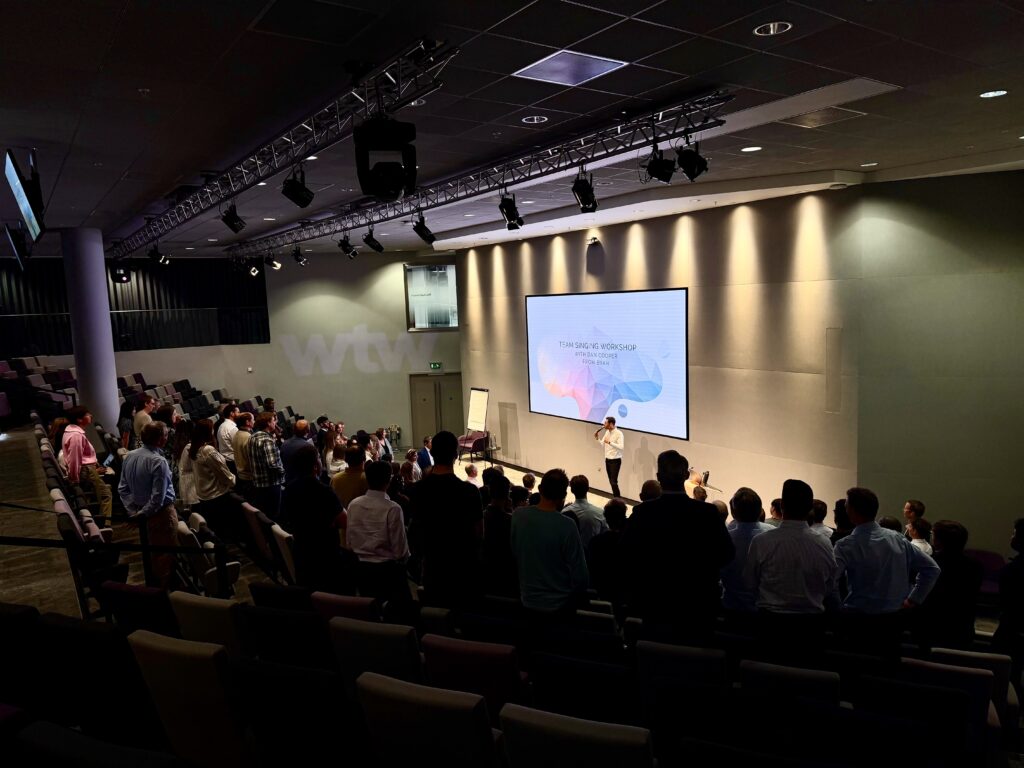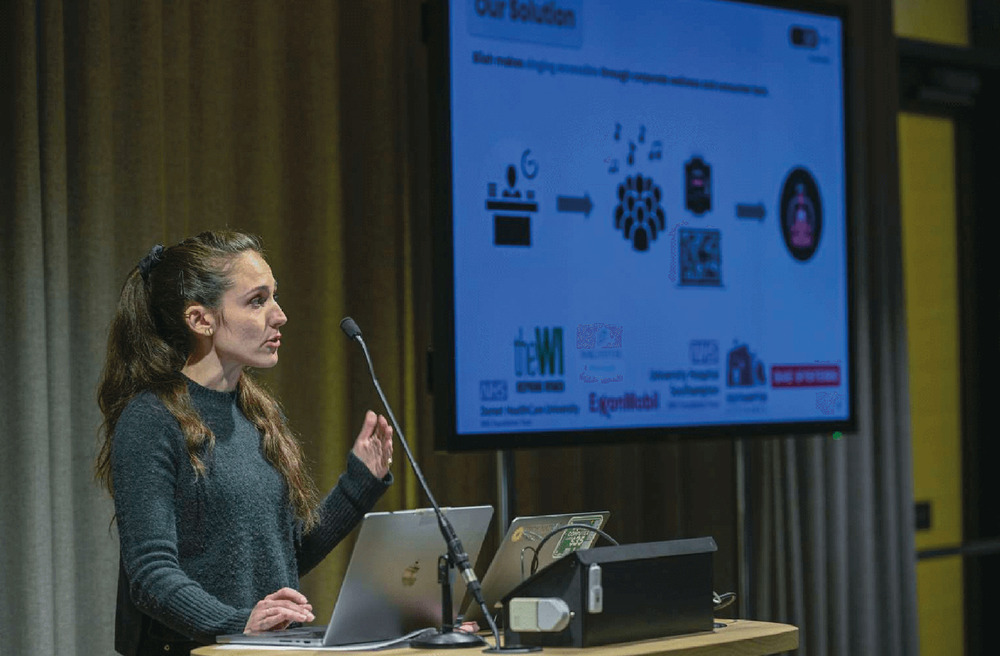Lullabies and Nursery Rhymes
From the moment we are born, singing has the potential to positively influence our wellbeing. Anthropological theories suggest that singing to an infant may have evolved to enhance mother-baby bonding, which in turn has been linked to positive cognitive and social development of the child. This bonding isn’t just great for babies, it’s also linked to psychological and behavioural states in mothers. One study found that perceived mother–infant closeness increased whilst mothers sang to their babies, over and above other activities such as talking and playing [4]. Another found that postnatal bonding was significantly greater 3 months after birth, in a group of mothers that sang to their babies compared to a group that didn’t [9]. Singing to babies on a daily basis has been found to be associated with lower symptoms of postnatal depression and enhanced wellbeing and self-esteem [2]. Even before the baby is born, one study suggests that listening to music during the third trimester of pregnancy could support mental health and well-being of the mother in the first 3 months postbirth [3].
Singing for survival
Fast forward to adulthood and singing is still an important bonding activity. Social cohesion in groups is an essential survival strategy for primates, including humans. In evolutionary terms, the time invested in social interaction had to be balanced against the time that could be invested on other basic needs such as finding food. So anything that sped up the process of bonding in the group was a bonus. Whilst primates bond their social groups through social grooming, humans have made social interaction more efficient by the acquisition of language to transform grooming into gossip! [10] Evidence from historical and anthropological records suggests that group music-making might also act as a mechanism by which this large-scale social bonding could occur, and that singing evolved as another way to enable social cohesion.
Singing as an ice-breaker
Modern humans are capable of sustaining much larger bonded social groups than any other primate. Generating cohesion in large groups requires some means of emotionally connecting many individuals simultaneously. Singing is a coordinated activity in terms of breath and heart rhythms, timing and pitch, and has also been linked with elevated β-endorphin levels – a neuropeptide known to be associated with social bonding. In a study comparing adult learners taking singing classes, with individuals participating in craft or creative writing classes, the singing activity bonded previously unfamiliar people more quickly than the other social activities, acting as a kind of social “ice-breaker”. [8]
A follow up study was carried out with members of a community choir that met in both small groups ( of between 20–80 people) and a ‘megachoir’ combining individuals from the smaller sub-choirs (232 people). The results showed that feelings of inclusion, connectivity, positive affect and level of endorphin released all increased across singing rehearsals. The team proposed that the finding that singing together fostered social closeness – even in large group contexts where individuals are not necessarily known to each other – is consistent with evolutionary accounts that emphasize the role of music in social bonding, particularly in the context of creating larger cohesive groups than other primates are able to manage [11].
Singing together doesn’t just bond previously unfamiliar people more quickly than other social activities, it can build connections that endure over time. In a 4-year study with members of a choir for older people, connections to other singers through social interactions within and beyond the choir, fostered social relationships on many levels, and enabled members to gain a sense of meaning alongside the accomplishment of learning and performing [7].
Singing to bridge social distancing
The social benefits of singing have never been more important than now. In spring 2020, the absence of traffic during lockdown silenced many Italian cities. This silence was broken by singing, individual households achieving cohesion during lockdown through singing on their balconies, singing functioning both as a coping strategy and a way to preserve a feeling of community [1]. This transcended generations with songs varying from traditional to classical and popular genres (see footage here [6]). Earlier this year, the Fijian Rugby team sang a touching tribute from their balconies to thank the staff who had looked after them in their quarantine hotel in Sydney [5].
Even if we can’t sing together right now, Biiah can help you to prepare – building skills and confidence – so that you are ready to get out there when we can!
Author: Dr. Sam Duffy
References
[1] Corvo, E. and De Caro, W. 2020. COVID-19 and Spontaneous Singing to Decrease Loneliness, Improve Cohesion, and Mental Well-Being: An Italian Experience. Psychological Trauma: Theory, Research, Practice, and Policy. (2020).
[2] Fancourt, D. and Perkins, R. 2017. Associations between singing to babies and symptoms of postnatal depression, wellbeing, self-esteem and mother-infant bond. Public Health. 145, 2 (2017), 149–152.
[3] Fancourt, D. and Perkins, R. 2018. Could listening to music during pregnancy be protective against postnatal depression and poor wellbeing post birth? Longitudinal associations from a preliminary prospective cohort study. BMJ Open. 8, 7 (Jul. 2018), 21251.
[4] Fancourt, D. and Perkins, R. 2018. The effects of mother–infant singing on emotional closeness, affect, anxiety, and stress hormones. Music & Science. 1, (2018), 205920431774574.
[5] Fijian rugby league players sing tribute to Sydney quarantine staff. BBC News Australia, 26 February 2021. https://www.bbc.co.uk/news/av/world-australia-56205627.
[6] Italians sing patriotic songs from their balconies during coronavirus lockdown. Christine Kearney, The Guardian, 14 March 2020. https://www.theguardian.com/world/2020/mar/14/italians-sing-patriotic-songs-from-their-balconies-during-coronavirus-lockdown.
[7] Lamont, A. et al. 2018. Singing in later life: The anatomy of a community choir. Psychology of Music. 46, 3 (2018), 424–439.
[8] Pearce, E. et al. 2015. The ice-breaker effect: Singing mediates fast social bonding. Royal Society Open Science. 2, 10 (2015).
[9] Persico, G. et al. 2017. Maternal singing of lullabies during pregnancy and after birth: Effects on mother–infant bonding and on newborns’ behaviour. Concurrent Cohort Study. Women and Birth. 30, 4 (Aug. 2017), e214–e220.
[10] Sutcliffe, A. et al. 2012. Relationships and the social brain: Integrating psychological and evolutionary perspectives. British Journal of Psychology. 103, 2 (May 2012), 149–168.
[11] Weinstein, D. et al. 2016. Singing and social bonding: Changes in connectivity and pain threshold as a function of group size. Evolution and Human Behavior. 37, 2 (Mar. 2016), 152–158.








